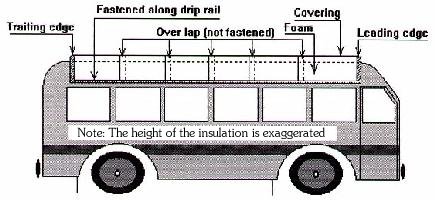![]() n the first trip in our coach, Sue (my wife) and I were awakened several mornings by the heat that radiated from the ceiling. The outside skin made an excellent solar collector, and the metal on the inside above the windows made almost as good a radiator. This area got so hot I could not hold my hand on it. While there was insulation in between the two panels, they both were fastened to the rib structure of the coach, which conducted the heat through. If the ribs of a coach are made of one eighth (1/8) inch thick steel, the heat conducted through a one foot section of the rib will be about the same as the heat coming through 30 square feet of
foam insulation. Any point where there is metal connected through the insulation, will be a point of MUCH greater heat transfer. To prevent this thermal short circuit through the insulation, there needs to be a continuous layer of insulation with an absolute minimum amount of metal that connects to both sides.
n the first trip in our coach, Sue (my wife) and I were awakened several mornings by the heat that radiated from the ceiling. The outside skin made an excellent solar collector, and the metal on the inside above the windows made almost as good a radiator. This area got so hot I could not hold my hand on it. While there was insulation in between the two panels, they both were fastened to the rib structure of the coach, which conducted the heat through. If the ribs of a coach are made of one eighth (1/8) inch thick steel, the heat conducted through a one foot section of the rib will be about the same as the heat coming through 30 square feet of
foam insulation. Any point where there is metal connected through the insulation, will be a point of MUCH greater heat transfer. To prevent this thermal short circuit through the insulation, there needs to be a continuous layer of insulation with an absolute minimum amount of metal that connects to both sides.
As the head room in our coach was already limited, putting more insulation on the inside was out of the question. Our solution was put it on the outside. We glued a one inch layer of polyurethane foam on the roof from the top of the windows on one side to the windows on the other. A covering of aluminum was added to protect the foam. We installed this in 1973, and now have 25 years of enjoyment from the results.

There are five areas to consider in this project. They are the insulation, the covering to protect the insulation, the leading and trailing edges where the insulation stops, fastening everything down, and the roof mounted accessories.
We used 1 inch thick polyurethane foam sheets from a commercial insulation supplier. Polyisocyanurate or Styrofoam could also be used. The Polyisocyanurate foam is sold at building supply centers and generally comes with a layer of aluminum foil on each side.
To cover the foam, several materials were considered. We settled on 24 gauge aluminum, which worked out well. There are several rubber roofing materials available for commercial buildings and RV roofs that should also work.
There is an interesting problem created by having pieces of metal on either side of a sheet of insulation. In the summer the outside is heated by the sun and expands, while the inside is cooled by air conditioning and contracts. In the winter, the temperature difference is in the other direction. To prevent problems, the sheets of aluminum were only fastened along the edge. When the temperature changes, the sheets will slide slightly, relieving the strain.
Some provision is needed to protect the ends. The aluminum covers the top of the foam, but the edge of the foam is exposed at the front and back (leading and trailing edges). There are any number of things one can do here. We made a bow from layers of hardboard and covered them with fiberglass.
The next problem is to determine how to fasten the aluminum along the edge above the windows. To get the most value from the insulation, it should extend down as close to the windows as possible. Unfortunately, many coaches like ours have a rivet line right there. They may also have a trim strip. Regardless of what is there, something solid is needed for the fasteners to tighten down on. A filler with enough thickness to match the thickens of the insulation is needed. If possible, this should be a poor heat conductor. As the outer skin does not take much load, weaker fasteners can be used than those needed for sheets that are part of the coach's structure. We used pop rivets. As they are soft, they could give a little without failing. This would relieve any substantial strain that might built up in the sheet.
If possible, the accessories should be mounted in the centers of the aluminum sheets, and kept away from the overlap areas. As the foam will not support a significant load, it must be removed and something stronger put in its place to support loads like an air conditioner.
George Myers is a retired 32 year veteran Electrical Engineer with over twenty years of experience working on bus conversions. George writes a monthly feature article for Bus Conversions Magazine entitled "Electrical Shorts".
